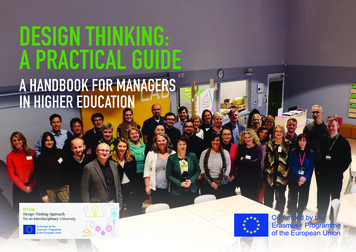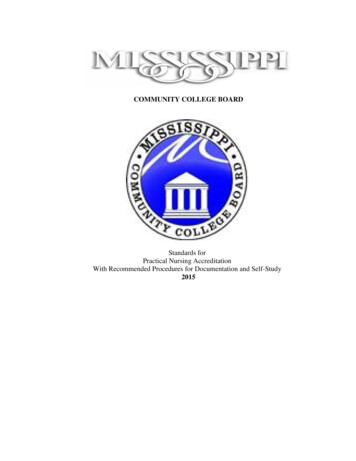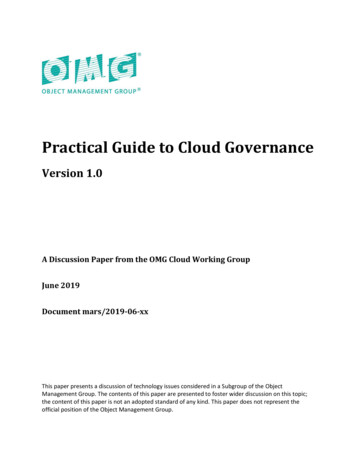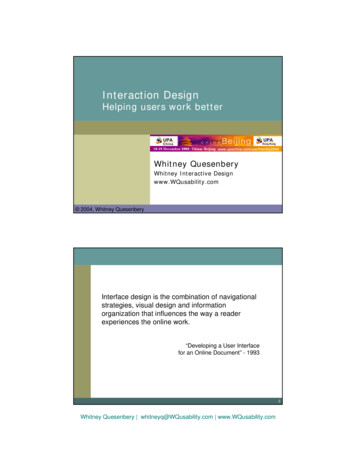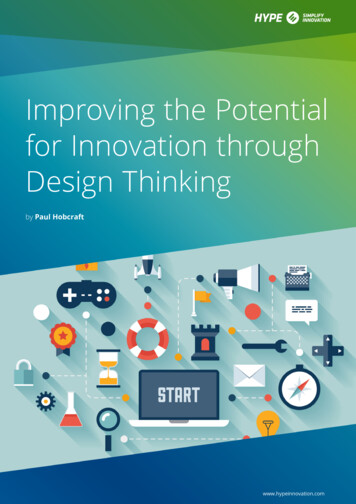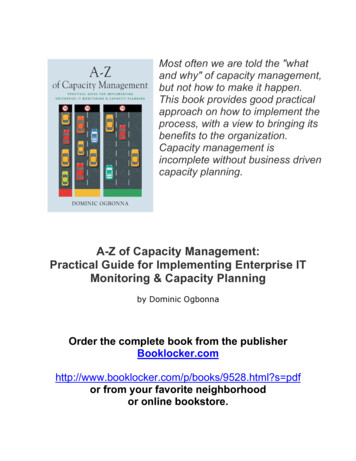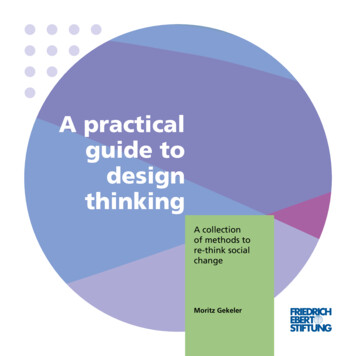
Transcription
A practicalguide todesignthinkingA collectionof methods tore-think socialchangeMoritz Gekeler
A practicalguide todesignthinking03
About the authorMoritz Gekeler, Ph.D., is a strategic facilitator and leadership coach for creative collaborationand co-innovation. 2019 Friedrich-Ebert-Stiftung India OfficeK - 70 B, Hauz Khas Enclave, New Delhi - 110016, IndiaResponsible:Patrick Ruether Resident RepresentativeDamyanty Sridharan Senior AdviserPhone: 91-11-26561361-64Website: www.fes-india.orgFacebook: Friedrich-Ebert-Stiftung, IndiaTo order publication:info@fes-india.orgCommercial use of all media published by the Friedrich- Ebert-Stiftung (FES) is not permitted without the writtenconsent of the FES.Friedrich-Ebert-Stiftung (FES) is the oldest political foundation in Germany. The foundation is named after Friedrich Ebert, the first democratically elected president of Germany.The views expressed in this publication are not necessarily those of the Friedrich-Ebert-Stiftung.Graphic Design: Myriam Rueda04
Background11The concept of design thinking13What is design thinking?15The three core elements of design thinking17Deconstructing stereotypes through creative collaboration25Structure of the project27Focus: gender equality27Results of the creative collaboration30A step-by-step guide35A thousand and one methods37Facilitate your team39Be curious!49Be compassionate!57Be creative!67Be constructive!73Pitfalls: Where to be cautious87Outlook: How design thinking could help in other projects91Partner organizations involved in the project95Endnotes97Bibliography10305
06
07
08
The need for moreout-of-the-boxthinkingFriedrich-Ebert-Stiftung (FES) has a long history ofworking on social issues: on improving workers’and women’s rights, on social inclusion, and ondemocratic accountability. With our large networkof partner organizations we have been constantlyworking on the reduction of gender inequalityby capacity building, socio-economic analyses andsensitization campaigns. Since 2015, however, wehave been wondering why, despite so much expertiseand good work, the situation of women has by-andlarge not really improved. Within the context ofAsian feminisms, we have realized that our work ongender equality has ended up going in circles. By nowwe have understood the root causes of inequality(capitalism, patriarchy) and have the moral highground (social justice) on what needs to change.Still, both men and women, and in fact all genderidentities, are trapped in a patriarchal system thatwithstands any efforts to make substantial changesto its power structures. We have organized seminars,trainings and campaigns, all working well for thosealready convinced of change. What we have failed todo though, is to get on board those women and menwho resist a progressive understanding of the term“feminism” and gender . Civil society organizationsand government programmes are stuck intechnocratic solutions like gender mainstreamingor over-emphatic political correctness. Largelydependent on donor funding, many organizationswith good intentions have become trapped inproject cycles and application writing. But actualalliances for change have seldom materialized.This was the point that started the FES India Officewanting to do things differently. We acknowledgethat patriarchy was the root cause of gender09
inequity , but did we ever actually try understandingthose in favour of the system? Did we—thatis, civil society—really put enough effort intoconvincing the other side why gender equalitymatters? Did we reach out to the fence-sitters andrally them to our cause? And, most importantly,who are we genuinely targeting with our ownwork, and why does that seem not to function?Gaining a fresh perspective on the allegedbeneficiaries of patriarchy seemed equallyimportant as questioning our own lines of work andconceptual approaches. With the help of the designthinking methodology we wanted to de-constructnot only patriarchy but also our own perceptionsand assumptions, which frame our work. “Why arewe doing this?” has become the new guidingquestion. Like the annoying child wanting toknow why, the continuous challenging of our ownmindset has led us closer to the truth and, yes, alsocloser to understanding the enormous challengeahead of us. We cannot change a running systemovernight, but we can certainly try doing thingsdifferently. And finally, we should get out of ourcomfort zone and interact with the Other. Ourexperience has shown that the world might not bethat black-and-white after all.Design thinking is neither rocket science nor apanacea. But it can surely help us re-image analternative world, and to tell a different storyabout life. We need to break out of our own workhabits and project cycles and just start doing thingsdifferently. This manual provides some guiding stepsto that path. There is no executive summary as itwould consist of the two things only: You and Why?Patrick RuetherDirector, FES India Office10
BackgroundThe use of creative concepts and innovativemethods—now often referred to as designthinking—was for a long time a niche practicefor nerdy Californian innovators, creative Germanproblem-solvers or arty Scandinavian designers. Butsince the turn of the 21st Century they have evolvedinto an approach applied by professionals fromdifferent fields and industries all over the world1.In the software industry the concept is widelyaccepted, though design thinking is also becomingpopular in other fields. In the social sector, big,very often American organizations such as the Bill& Melinda Gates Foundation2 , the Acumen Fund3and others4 have been playing around with designmethods. Smaller organizations or even local nongovernmental organizations (NGOs) are only slowlygaining some exposure to it.5The Friedrich-Ebert-Stiftung (FES) India Office hastaken on the challenge of applying design thinkingwith their partner organizations in a context that isless product- and business-oriented. The goal wasto enable experts from the partner organizations tothink differently about a topic that they have beenworking on for years or even decades: improvinggender equality in India.This publication will give you an insight into theprocess, the strengths and specific challenges ofthe approach. It features experiences from the FESpartner organizations and finally offers a practicalguide to some of the methods that have beenused throughout the process. This guide has beendesigned on the basis of the process that the groupof partners and FES colleagues have gone through.It is not seeking to be a comprehensive collectionof design methods, but should act as a reminderfor the project team of the methods they havebeen using. Additionally, we publish these methodsto help other organizations in the social sector toidentify how design thinking might be useful forthem and to provide some tools for thinking morecreatively and collaboratively about their respectivetopics. Most methods have not been developedspecifically for this project, and we will providelinks and resources for further engagement withthe concepts.11
12
Theconcept ofdesign thinking13
14
What isdesignthinking?“Design thinking is a way of finding human needsand creating new solutions using the tools and mindsets of design practitioners.”6 – David & Tom KelleyThis quote from David and Tom Kelley verybroadly defines the concept of design thinking.The simple way in which the two brothers from PaloAlto, California, formulate it highlights the ratherhigh aspiration behind the concept: design andits methods can be used to solve challenges thathuman beings face. Throughout the literature thechallenges that are best suited for design thinkingare described in more detail: Design thinking worksbest when the problem is ill-defined7, or “wicked”as Richard Buchanan and others have called it8. Itshould not have one single answer. Rather, severalanswers might be equally valid, although maybenot equally desirable. In short: Design thinking isuseful when the problem is complex.9Additionally, the aforementioned definition ofdesign thinking suggests that those tools andmindsets can be used not only by the designpractitioners themselves, but also by otherprofessionals. As the famous French-Americandesigner Raymond Loewy is said to have remarked:“Design is too important to be left to thedesigners.”10 Instead, people from differentdisciplines should come together, collaboratecreatively and thus create new solutions.But why should the tools and mindsets of designpractitioners be of any help in solving thesechallenges? In order to answer this question, let ustake a look at the world as it appears today.A short historyof design thinkingOver the last two decades the pace of change hasincreased dramatically. Even though statisticianssuch as Hans Rossling have proven that this changehas usually been for the better11 , on a global scalemany new challenges have evolved without the oldproblems being solved. New technologies such asthe computer and smartphone, and others yet tocome such as artificial intelligence or robots12, willincrease the speed at which humankind innovates15
and adapts to a changing world.The capitalistic mindset of the 20th Century withits methodologies and strategies—namely anindustrial, profit-driven and top-down approachbased on a patriarchal system—have managed tobring much prosperity to some parts of the world,while leaving others way behind. In the highlycompetitive business world of over-saturatedmarkets, only those companies are to thrive thatmanage to distinguish themselves from othersand to create added value for the consumers. Thecapitalistic race for higher margins and shareholdervalue have contributed significantly to greaterphenomena such as climate change, air and waterpollution, or the emergence of new forms ofbonded labour across the globe, to name a few. In2018 these megatrends can no longer be considereda somewhat distant sword of Damocles, but havebecome reality in daily life, in the form of draughts,heat waves, smog clouds, plastic islands in ouroceans, etc. The sword is not somewhere above ourheads but has already begun falling.In recent years it has thus become more and moreobvious even to the wider public that the mindsetand strategies of the 20th Century will not be able toproduce solutions to problems that they themselveshave created or at least accelerated. Based on thisinsight the search for alternative approaches hadbegun. Initially, companies were merely lookingfor better ways of differentiating themselves fromtheir competitors. Design and its methods seemedpromising. Organizations like Apple were doingincreasingly well by focussing all their efforts oncreating experiences for their customers rather16than just selling interchangeable products tothem13.Around 2003/2004 Hasso Plattner, one of thefounders of the software company SAP, readabout David Kelley’s d.school, which is connectedto Stanford University in Palo Alto. David useda process that he called design thinking to letstudents collaboratively work on problems thatare not easily analysed. Similar approaches andmethods had been taught successfully aroundthe world before, but usually to students whowere aspiring to become designers themselves. AtStanford, David invited students from all kinds ofdisciplines into what he called the d.school14. Hewanted to teach his students to become innovatorsrather than administrators in their respective fieldsand even across disciplines.The following meeting between Hasso and Davidaccelerated the subsequent rise of design thinking.Hasso generously funded the d.school at Stanford,which since then has spread around the world fromPotsdam, Germany, to Cape Town, South Africa,and then on to Kuala Lumpur, Malaysia, and Beijingin China.15 Other schools from various backgroundsare also introducing a design-thinking approach.The company SAP, which touches the lives of millionsof employees in various sectors, also introduceddesign thinking and it was only a matter of timeuntil design thinking also became popular in theboard rooms of companies as diverse as PepsiCo,Daimler, IBM or even traditional consultancies suchas McKinsey or Accenture.
Tackling the way of workingvs the workshop approachIn the course of these developments designthinking has evolved from a profession (traditionaldesign) into a novel approach that helps peoplesolve their respective challenges in a more creative,human-centred, collaborative, iterative and visualway (design thinking)16. There often is a discussionaround how design thinking is to be done correctly.Many employees of the companies mentionedabove say that design thinking is best done in aworkshop format. If you ask members of designagencies or professional design teams within thoseorganizations they strongly disagree and say thatdesign thinking is rather embedded in their wayof working, and might but equally might not alsohappen in a workshop format.One reason for this discrepancy lies in the amountof training both sides have put into learning themethods and approaches of the designer. Whileclassical designers have studied the profession andworked creatively more or less all through theiruniversity life and professional career, employeeswith a background in a different field usually learnabout design thinking through highly engagingtraining formats. Therefore, these workshop-liketrainings become what they think of as designthinking, and it takes a long time and a lot ofpractice for people to introduce the principles ofdesign thinking into their regular work routines,as opposed to holding dedicated design-thinkingworkshops.Nevertheless, even short-term design-thinkingwork-shops have their value, since they enableteams to approach their challenges in a different,more creative and more human-centred way.17 TheFES project on which this paper is based wasconceptualized as a series of workshops. However,the partner organizations of FES applied themethods according to their needs in between themeetings. The goal was to enable the partnerorganizations to look at their respective fields ofwork from a different perspective.The three coreelements ofdesignthinkingHow does design thinking enable this differentperspective? At its core, design thinking is acollaborative and ideally multidisciplinary approach.That is the biggest difference from classical designas well as from other disciplines.While traditional projects in the corporate world,the classical design world and also in the social17
sector are usually based on cooperation, designthinking is based on collaboration. Cooperation inthis sense means that people work together as ateam but are not necessarily all involved in all stepsof the process. A design-thinking team on the otherhand ideally works together and decides together,therefore each team member is involved in all stepsof the process (see Image 1).In order to ensure that this collaboration works wellfor the team members and also that it producesresults within an acceptable time frame18, designthinkers make use of three core elements: people,place and process19.Be mindful of peopleAnything that a design thinker does is based on anattempt to better understand the human being. Infact the term human-centred design can be usedalmost synonymously with design thinking. This attitude of being mindful of people has at least twosides20 : the focus on the team on the one hand andthe focus on the target audience or user21 on theother.The team and their experienceAs mentioned, the team in a design-thinkingproject should ideally be diverse in terms of gender,Image 1: Projects based on cooperation vs. on ource: Andrea Augsten and Moritz Gekeler, “Für einen Paradigmenwechsel in der Designlehre des 21. Jahrhunderts: WelcheHaltungen braucht kollaboratives Design?”, in: J. Parks, Design & Bildung – Schriften zur Designpädagogik, Band 2 (Munich:Kopaed, 2018, pp. 32-33), translated by the author.18
backgrounds and skills. For example, an engineercould work with a social worker, a designer, aphilosopher and a business expert to solve whateverchallenge they are working on. The concept of the“T-shaped person” describes how the people inthis team should be selected: the vertical line ofthe T describes the depth of any given expertise(e.g. design22, social work, psychology or business),while the horizontal line symbolizes the ability andwillingness to reach out to others and to bridge thegap between the disciplines. This requires an open,curious and empathetic attitude23 towards otherpeople, and less of the imagined omniscience ofsome domain experts. In general, design thinkingrequires the team members to take an innocentperspective in order to be able to learn somethingnew.In reality many organizations do not have thediversity that would be ideal for this kind ofwork, though. In this case it is useful to highlightand embrace the diversity on other levels, suchas character or working style. Additionally, a truedesign thinker would always bring on otherperspectives during a project, e.g. throughinteraction or even co-creation with the targetaudience, experts or other people who cancontribute their views and ideas to the project.Design-thinking teams also take responsibility formaintaining a good team spirit by exchangingconstantly about their behaviour, their feelings andemotions. Games and other fun team activities helpthe team members to get to know each other in amuch richer way.The audience and their contextWhenever you read about design thinking, you willdefinitely find the user focus to be a very importantelement. A design-thinking project has at its corethe needs, wishes, aspirations and the context ofthe people it ultimately serves. Since it does notmake sense to talk about users in the context ofsocial activism or social work, terms like audience oreven just person or human being seem to be moresuitable.Working with design thinking, the team ensureto always keep the human being at the coreof whatever they are doing: They take care tounderstand the situation and the context of thathuman being—the challenges and opportunities,the wishes and needs. They try to understand thetarget audience of the final concept or solution (e.g.girls who should be empowered to go to school). Buta design thinker will also try to understand otherstakeholders who are important in that situation(e.g. fathers who think that too much educationwill make it difficult to find a good husband fortheir daughters). Through thorough ethnographicresearch they try to get a good understandingof the system in which they are operating. Thisinvolves constant interaction with the people whoare affected or even causing the problem, or whohave any other helpful information concerning thegiven challenge.2419
Be mindfulof the (work) placesolutions”. Usually the little word “new” carries alot of importance whenever design thinking is used.In order to support the team, it is helpful towork in a space that is flexible. Many traditionaloffices have very heavy furniture, which cannot beremoved from the room, or they have policies whichdo not allow for the employees to mess with theinterior design. If you are working in a traditionalconference room or banquet hall of a hotel, thestaff usually obligingly bring enormous tables andunwillingly destroy any flexibility that an emptyroom would give you.The reason for many organizations to even lookat an approach like design thinking is the needfor innovation. The problem here is that the team(or even the sponsor, supervisor or president of anorganization) cannot know at the outset of a projectexactly what the outcome will be. That actually isthe whole point of the exercise. If you think youknow exactly what the outcome is, you do notneed a design-thinking approach.27 But wheneveryou have no clue what solution could help solve thechallenge or which solution is the best one, designthinking might help. Especially when the challengesare rather complex in nature and could be solved inmany different ways.In an ideal set-up on the other hand, the roomshould inspire creativity and should be flexibleso that the team can move the furniture aroundwhenever they need. Instead of being constrainedby the built environment, the team should beable to decide what space they need at any givenmoment. Scott Whithofft and Scott Doorley havewritten a very useful book that explains how spacescan be designed in a way that encourages peopleto collaborate with each other and be creative.25If you do not have the financial means to changethe whole office set-up, some very simple tools suchas rolls of brown or white paper, sticky notes andmarkers will take you a long way.26 Even changingthe setting for a day or two, working from a parkor from a coffee shop, will help you in changingperspectives.Be mindful of processDavid and Tom Kelley describe design thinking as“a way of finding human needs and creating new20If you search the internet for images related tothe term “design thinking”, you will find manyprocess visualizations. This is because beingmindful of your process is very important to ensureproper collaboration and avoid getting lost in theopenness of the whole endeavour. The team shouldbe able to mutually understand where they are inthe process and what has to be done in order tobe comfortable with not knowing exactly what thefinal outcome will be.The visualization that comes closest to theexperienced reality of a design-thinking projectis the “design squiggle” coined by DamienNewman.28At the beginning of the project a lot of researchhas to be done to understand the challenge better
Image 2: The design squiggle by Damien NewmanUncertainty / patterns / insightsResearchClarity / FocusConceptDesignSource: Damien Newman, https://thedesignsquiggle.com/ (accessed: 13.12.2018)and build empathy for the target audience. In thisphase the team might feel a little lost sometimes,but through broad research (ideally the attempt toget a 360 view) they will eventually find patternsand reach insights that then lead to initial ideas,prototypes and, with increasing clarity and focus,finally to a very concrete design. The challenge forteams that are new to a process like this is to makethem feel comfortable with not knowing wherethe process will lead them. An experienced designthinker will just simply trust the process, havingseen it work so many times.use a very simple trick. They pay attention to theirown thinking style and consciously adjust it. A veryopen style that values every observation, everyinsight and every idea, as small and irrelevant as itmight seem (divergent thinking), is differentiatedfrom a more selective, critical and picky approachthat enables the team to find patterns in thepreviously generated abundance of data, and tomake choices (convergent thinking). These twothinking styles are strictly separated from eachother to enable the team to leave the area of theknown and consciously go forth into an area ofdiscovery.29Divergent vs. convergent thinkingIn order to structure this seemingly chaotic process,design thinkers and other creative problem solvers21
Separating the researchfrom the search for a solutionAdditionally, design thinkers apply another simpletrick: they separate the analysis and understandingof a problem from the search for the solution. Thisway they can ensure that the final solution is actuallybased on needs and observations that are gatheredin the research phase. Especially this second tricksounds extremely simple, but it turns out that manypeople find it easier to directly jump to conclusionsand to solutions rather than spending time onanalysing the problem from different perspectivesfirst.The double diamondImage 2 shows an idealized version of the designprocess, and visualizes the thinking styles and tricks.This process visualization highlights the thinkingstyles of divergent and convergent thinking and thetrick of separating “understanding the problem”from “solving the problem”. It also differentiatesfour attitudes that are predominant in each phaseof a project.During the initial research phase, the prevalentattitude is curiosity. The goal of this phase of adesign thinking project is to learn as much as youcan about the given challenge and its context.After that, while convergently finding patternsand selecting insights, the team compassionatelydescribes the target audience and the situation inwhich the challenge occurs. In this phase the teamreformulates (“re-frames”) the initial challenge intomore meaningful problem statements, which willhelp them at the beginning of the next phase to becreative and have better ideas. If the research hasdicogeernvTHE PROBLEMTHE passionateUNDERSTANDSource: Adapted from the ”Double Diamond“ by the British Design Council.22ergge veer nnv cocodivevergergeImage 2: The double diamond shows the different thinking styles, tricks and attitudes
been done well the team builds not only anintellectual but also an emotional understandingof the problem they are working on. Being creativein this context means developing as many ideas aspossible. No idea is too crazy or too challenging.Again, this is part of the divergent way of thinking.Only in the final phase the team select ideas. Nowit is time to be constructive in two ways:§§ They build prototypes of their respective ideas.§§ They test them with the target audience andexperts, and constructively collect feedback.That feedback starts a loop that brings the teamback to being curious. Compassionately, they thenmake sense of the collected feedback, find creativesolutions to the issues that have been raised inthat feedback, and build the next iteration of thesolution. Design thinking is never a linear process—instead it involves constant exchange with thetarget audience and other experts in order toimprove the solution well before implementing it.23
24
Deconstructingstereotypesthrough creativecollaboration25
26
Structure ofthe projectDesign-thinking methods were used in this projectas a catalyst for more creative, collaborative andsystemic thinking. During a series of workshops thepartner organizations were enabled to use designthinking methods such as the ones featured in thispublication.Before and between the workshops the participantswere directed to do homework such as field research,creating mood boards and personas, or developingtheir prototypes further. Each homework task wasrelated to one or more design methods that wereapplied and discussed during the workshops.The workshop series culminated in a “train-thetrainers” session, where the participants discussedand practised certain facilitation techniques inorder to be more confident in using the describedtools and exercises with their teams and their targetaudiences.Image 3 shows this approach visualized accordingto the “Learning Arches”, which the famouscreative leadership school Kaos Pilots in Aarhus,Denmark30, uses for planning its learningengagements. Each arch represents a phase in thelearning journey and the correlated goals. Sincedesign thinking is an iterative process, theworkshop series was not planned according to thedesign phases. Instead, each workshop consisted ofseveral design phases, where the different mindsetsand approaches had to be used. As early as the firstworkshop, the teams came up with initial ideas andthen went back to their respective organizations todo more research or to develop them further. In thesecond workshop several iterations were exploredto look at the concepts with a critical mind and todevelop better prototypes.The guiding principle behind the design of theworkshop series was that whatever topic, methodor exercise has been started should be brought toa thought-out conclusion. Nevertheless, one coregoal of the whole project was to bring new ways ofworking to the partner organizations.Focus:genderequalitySince the topic of the project was gender equality,the obvious choice as a focal point for research andfuture solution proposals were the women andgirls who face unequal treatment. The gender unitpartners of FES India who went through the designthinking journey have been working with womenand girls since many years. Still, they were open27
Image 3: The design of the workshop seriesSTART WORKING DIFFERENTLYDESCONSTRUCTING STEREOTYPESTHROUGH CREATIVE COLLABORATIONUse the methods with your teamand other stakeholdersEstablish morecreative confidenceEnable FES partners to use design methodsGive them an experience of design thinkingTry it outLearn from itApply itDEVELOPA NEW CONCEPTOR PROCESS,ITERATE ITAND IMPLEMENT ITDEVELOPINITIALIDEASHOMEWORKDo uss the researchIdeate first conceptsDig deeper in research& ideation methodsMake a game plan28ITERATETHEIDEASHOMEWORKDo moreresearchIterate yourconcepts ordevelop new onesWORKSHOP2DELHIIterate the ideasLearn about designfor behavioral changePrototype the ideasHOMEWORKIterate coreconceptfurtherTest itImplement itWORKSHOP3JAIPURLearn how tofacilitate othersusing designmethods
The FES Project: Political feminismDamyanty Sridharan, Senior Advisor for Gender and Social Justice (FES India)The vocabulary of feminism the world over today is, unfortunately, more disengaging than engaging. In India as elsewhere, the feminist space has a distinctive identity, butbuilds upon a diversity of women’s groups, individuals, institutions and movements. Despite this broad basis of experience, or perhaps because of it, this space remains disunited. Alongside the traditional women’s movement, newgroups have arisen, and not all of them are or even want tobe called feminist. It is imperative to recognize the diversityof their ideas and reasoning. For the Friedrich-Ebert-Stiftung(FES), with its commitment to the values of freedom, equality, democracy and social justice,
design thinking? “Design thinking is a way of finding human needs and creating new solutions using the tools and mind-sets of design practitioners.”6 – David & Tom Kelley This quote from David and Tom Kelley very broadly defines the concept of design thinking
